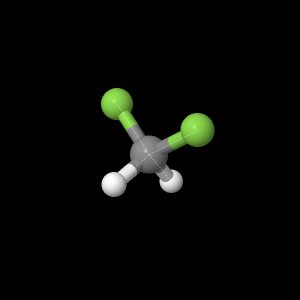Once the molecule file is fully loaded the image at right will become live. At that time the "activate 3-D" icon
![]()
will disappear.
The geometry optimizations for the three
highest levels of theory are shown below. The following graphics show both the bond length and bond angles.
6-21G was the lowest level of theory used for the geometry optimization.
6-31G was the next highest level of theory used for
the geometry optimization. This level of theory was the best for
geometry optimization due do the fact that the bond lengths and angles
came closest overall to the literature
2 values shown in tables 1 and 2.
DZV was the highest level of theory used to determine geometry optimization.
The bond lengths can be compared to their experimentally derived literature values shown in table 1 and angles in table 2.
Table 1: Bond lengths from the literature2. Note that for C-H and C-F both bonds are the same length.
C-H bonds
|
1.0840 angstroms
|
C-F bonds
|
1.3508 angstroms
|
Table 2: Bond angles from literature2. Note that bonds of the same type had the same angle.
Type of Bond
|
Bond Angle in degrees
|
F-C-H
|
108.866
|
H-C-H
|
112.800
|
F-C-F
|
108.490
|
The partial atomic charge on each atom is shown in
this diagram. They are created by the asymmetric distribution of
electrons in a chemical bond.
This is the lowest unoccupied molecular orbital at
orbital 14. This would become occupied if the molecule was excited
with the proper amount of energy.
This is the highest occupied molecular orbital at
orbital 13. The orbitals were calculated by summing the amount of
electrons in the molecule and dividing by two.
This is the electrostatic potential of the molecule. The red area
represents the lowest electrostatic potential and blue represents the
highest electrostatic potential. Intermediate colors represent
intermediate potentials.
The vibrational frequencies were calculated using the
highest level of theory, DZV. The frequencies would equate
to peaks on a IR spectrum, but one was not able to be obtained.
The different frequencies were obtained from an IR manual and are shown
in table 3.
Table 3: Type of bonds and their expected
peaks in an IR spectrum. Note that the bonds in CH2F2 might
produce slightly different frequencies due to interactions in the
molecule.
Type of Bond
|
Frequency in cm-1
|
C-H bond stretch
|
2850-2950
|
C-H oscillation
|
1260
|
C-H oscillation
|
1380
|
C-F bond stretch
|
1000-1100
|
The following graphics show the calculated
vibrational frequencies using DZV. You can click on the buttons to
view the actual types of vibrations the molecule is experiencing at
each frequency.
The dipole moment was calculated at the different
levels
of theory to determine the best answer. The best theory was AM1
and gave a value of 2.040583 debyes, compared to the literature value of
1.970 debyes. This gave an error of 3.6%. This result is
surprising as AM1 is the lowest level of theory and uses the smallest
basis sets.
You may look at any of these intermediate views again by clicking on the appropriate button.
Based on template by A. Herráez as modified by J. Gutow
Using directory /Users/student/Desktop/AN371/Website/CH2F2
adding JmolPopIn.js
...jmolApplet0
...adding 6-21G_Bond_Length.png
copying and unzipping jsmol.zip directory into /Users/student/Desktop/AN371/Website/CH2F2
...copying
file:/Users/student/Desktop/AN371/CH2F2/CH2F2-621G.log
to
/Users/student/Desktop/AN371/Website/CH2F2/CH2F2-621G.log
...adding 6-21G_Bond_Length.spt
...jmolApplet1
...adding 6-21G_Bond_Angle.png
copying and unzipping jsmol.zip directory into /Users/student/Desktop/AN371/Website/CH2F2
...adding 6-21G_Bond_Angle.spt
...jmolApplet2
...adding 6-31G_Bond_Length.png
copying and unzipping jsmol.zip directory into /Users/student/Desktop/AN371/Website/CH2F2
...copying
file:/Users/student/Desktop/AN371/CH2F2/CH2F2-631G.log
to
/Users/student/Desktop/AN371/Website/CH2F2/CH2F2-631G.log
...adding 6-31G_Bond_Length.spt
...jmolApplet3
...adding 6-31G_Bond_Angle.png
copying and unzipping jsmol.zip directory into /Users/student/Desktop/AN371/Website/CH2F2
...adding 6-31G_Bond_Angle.spt
...jmolApplet4
...adding DZV_Bond_Length.png
copying and unzipping jsmol.zip directory into /Users/student/Desktop/AN371/Website/CH2F2
...copying
file:/Users/student/Desktop/AN371/CH2F2/CH2F2-DZV.log
to
/Users/student/Desktop/AN371/Website/CH2F2/CH2F2-DZV.log
...adding DZV_Bond_Length.spt
...jmolApplet5
...adding DZV_Bond_Angle.png
copying and unzipping jsmol.zip directory into /Users/student/Desktop/AN371/Website/CH2F2
...adding DZV_Bond_Angle.spt
...jmolApplet6
...adding Partial_Atomic_Charge_.png
copying and unzipping jsmol.zip directory into /Users/student/Desktop/AN371/Website/CH2F2
...adding Partial_Atomic_Charge_.spt
...jmolApplet7
...adding LUMO.png
copying and unzipping jsmol.zip directory into /Users/student/Desktop/AN371/Website/CH2F2
...adding LUMO.spt
...jmolApplet8
...adding HOMO.png
copying and unzipping jsmol.zip directory into /Users/student/Desktop/AN371/Website/CH2F2
...adding HOMO.spt
...jmolApplet9
...adding Electrostatic_potential.png
copying and unzipping jsmol.zip directory into /Users/student/Desktop/AN371/Website/CH2F2
...adding Electrostatic_potential.spt
...jmolApplet10
...adding 1144_97_CF_Stretch.png
copying and unzipping jsmol.zip directory into /Users/student/Desktop/AN371/Website/CH2F2
...copying
file:/Users/student/Desktop/AN371/CH2F2/CH2F2-DZVvib.log
to
/Users/student/Desktop/AN371/Website/CH2F2/CH2F2-DZVvib.log
...adding 1144_97_CF_Stretch.spt
...jmolApplet11
...adding 1235_CH_vibration.png
copying and unzipping jsmol.zip directory into /Users/student/Desktop/AN371/Website/CH2F2
...adding 1235_CH_vibration.spt
...jmolApplet12
...adding 1354_CH_vibration.png
copying and unzipping jsmol.zip directory into /Users/student/Desktop/AN371/Website/CH2F2
...adding 1354_CH_vibration.spt
...jmolApplet13
...adding 3378_CH_stretch.png
copying and unzipping jsmol.zip directory into /Users/student/Desktop/AN371/Website/CH2F2
...adding 3378_CH_stretch.spt
![]() will disappear.
will disappear.
